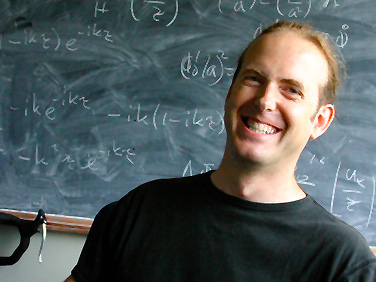News
A sibling universe? Maybe not

UB physicist Will Kinney and colleagues completed a study whose results challenge earlier research suggesting that something massive exists outside the bounds of our visible universe. Photo: PATTY WALLACE
In 2008, a research team led by a NASA scientist announced a startling discovery: Clusters of galaxies far apart from one another appeared to be traveling in the same direction.
The findings contradicted the standard model of the universe, which predicts that, as a whole, mass within our universe should flow randomly, in all directions, relative to the background radiation of the cosmos.
The one-way “dark flow” that the NASA-led group discovered created a mystery. What could account for the unexpected motion? Maybe another universe existed beyond the bounds of ours, dragging our stars ever closer through the pull of gravity.
Then again, maybe not.
A new study from UB contradicts the dark-flow theory, showing that exploding stars in different parts of the universe do not appear to be moving in sync.
Working with data on 557 such stars, called supernovae, UB scientists deduced that while the supernovae closest to Earth all shared a common motion in one direction, supernovae further out were heading somewhere else. The difference in motion became pronounced for stars 680 million or more light years away from Earth.
An article announcing the research results will appear in a forthcoming edition of the peer-reviewed Journal of Cosmology and Astroparticle Physics.
Though the findings disagree with the “dark-flow” hypothesis, they coincide with the predictions of another model of the universe: Lambda-Cold Dark Matter, the standard model of cosmology.
“Our result is boring, in a way, because it matches your expectation for the standard cosmological model,” says William Kinney, associate professor of physics. “If it turns out that the NASA team led by Alexander Kashlinsky is right, it would be exciting because there would be some crazy thing going on that nobody understood. There would have to be something very radical, like a big mass outside of our universe that’s pulling on stuff inside our universe. That would be big news.
“But our data does not match theirs,” Kinney continues. “With our study, we’re muddying the water. It’s not yet clear who is right. We have to do more figuring to build up a more-detailed and accurate picture of the universe.”
Kinney completed the study on supernovae with De-Chang Dai, a UB postdoctoral researcher who has since joined the University of Cape Town, and Dejan Stojkovic, UB assistant professor of physics.
The supernova data the team used to complete their study came from the Union2 data set, which the Supernova Cosmology Project at the Lawrence Berkeley National Laboratory released in 2010. Though Union2 incorporates astronomical observations from different telescopes and different times, the data set controls carefully for systematic bias and serves as a useful check for the possible presence of systematic errors in the work of Kashlinsky and others, Kinney says.

Reader Comments